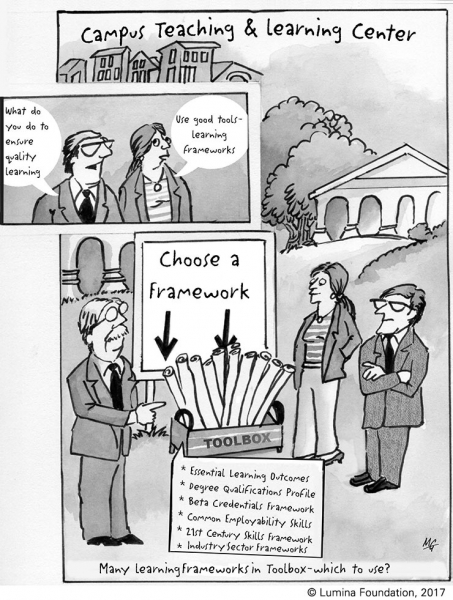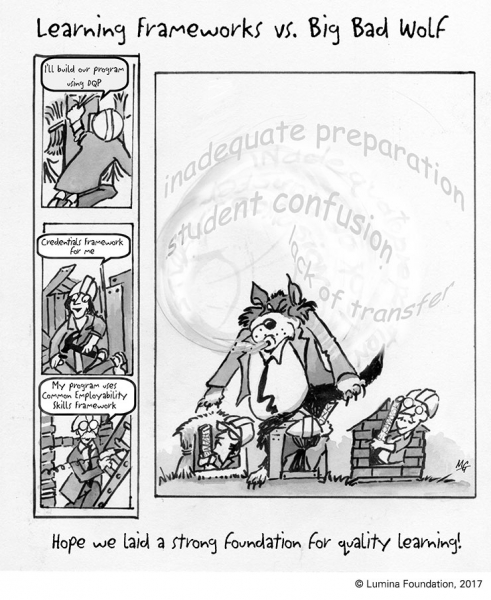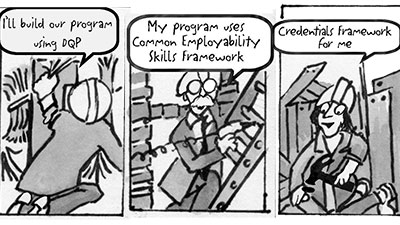If we were building a house together, or in this case, trying to remodel the nation’s “house of credentialing,” we’d look at the foundation first. That is, the building blocks of credentials such as degrees, certificates, industry certifications, badges, and licenses. How do education providers ensure these credentials offer value in the form of real learning?
That’s where frameworks come into play. Frameworks are tools used to establish clear and transparent learning outcomes for courses, programs, and credentials. Put another way, frameworks are the blueprints we use to make sure the foundations of all credentials are strong. However, not all credentials use blueprints or build from strong foundations. This shortcoming results in great variation in quality among credentials.
We can change this practice if we redesign the credentialing system ─ and learning frameworks can help bring about such change. These frameworks won’t magically make all credentials high quality. But, without frameworks ─ blueprints developed by credible experts to reflect the changing landscape of learning and work through key external reference points ─ we cannot build curricular pathways and help learners use those pathways to earn high-quality credentials and secure meaningful employment.
Whose job is it to assure that credentials stand for quality learning? For academic credentials, it’s the job of college and university faculty members. Employers, too, play a vital role by working with the faculty to ensure the academic curriculum imparts relevant knowledge and skills. Regional, national, and professional accrediting bodies play roles as well as third-party standard-bearers. And in many fields, third-party assessors test learners to ensure they have gained the knowledge and skills that qualify them for industry certifications.
The process starts with faculty bodies establishing specific, transparent learning outcomes. These outcomes are expressed as clear descriptions of what students should know and be able to do as a result of completing their courses and programs. Frameworks that describe the most important learning outcomes and competency statements are the blueprints ─ or, external reference points ─ for such work. But there are many learning frameworks out there. Which ones should faculty members use to guide development of their programs and levels of learning? What types of skill and knowledge acquisition should be embedded in their curricula? Who should assess their efforts to build these strong foundations? And how do they get started?
First, faculty members are faced with trying to understand which frameworks ─ tools in the increasingly crowded framework toolbox ─ they should use. They need information about the value, purpose, and use of each one.

Once they decide which framework or frameworks will help them build a solid foundation for learning, the next test comes: How do they know the foundation is strong? Data can provide the answer. For example: Are the learning outcomes for the courses and programs clear to students? Are students prepared to master the learning objectives of their courses and programs? Do their pathways feature applied-learning experiences and well-designed assignments that allow for meaningful assessment? Can students show they have acquired knowledge, skills, and abilities that will open the next doors in their journeys, whether to further education or employment? Are students able to transfer seamlessly from program to program and institution to institution? There’s a price to pay when strong foundations don’t support credentials. For instance, students can be confused about what they’re learning; credit hours may not transfer to other programs or institutions; or a program’s graduates may not be prepared adequately for what they encounter after they leave school.

Of course, the learning framework is only the foundation, the first step to building a strong house for all credentials, both in education and in workforce training. It’s also important to remember that blueprints can be used to design multiple houses ─ each with different features. The blueprint is a foundation, a starting point, not a rigid “cookie-cutter” tool that eliminates appropriate differences and variations among credentialing pathways.
Many other components are essential to building a high-quality house of credentialing. These include training for faculty members; sufficient time and resources to create foundations for learning; continually updated building materials; use of conventional building codes, or standards so that students can move seamlessly among many different houses of learning; and useful assessment tools and trained assessors to evaluate the outcomes of learning. But the foundation is where the work must begin.
So, let’s use learning frameworks to ensure that the foundations of all credentials are sound. This practice can carry the credentialing marketplace a long way to the redesigned system we need ─ to help students learn and earn strong credentials and use that learning to meet their educational and employment goals.
